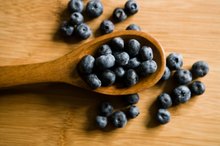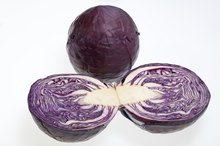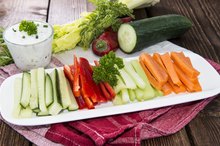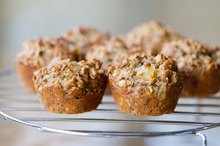What does fact checked mean?
At Healthfully, we strive to deliver objective content that is accurate and up-to-date. Our team periodically reviews articles in order to ensure content quality. The sources cited below consist of evidence from peer-reviewed journals, prominent medical organizations, academic associations, and government data.
The information contained on this site is for informational purposes only, and should not be used as a substitute for the advice of a professional health care provider. Please check with the appropriate physician regarding health questions and concerns. Although we strive to deliver accurate and up-to-date information, no guarantee to that effect is made.
Information for Kids on Antioxidants
Most parents, teachers, pediatricians and other caregivers want children to eat healthy diets. But unhealthy choices are seemingly everywhere: from the fast-food drive-through to french fries in the school lunchroom. It can be challenging to get children on board with healthy eating when sugary, high-fat food is so readily available. One way to encourage kids to eat healthfully is to educate them about nutrients, such as the importance of antioxidants.
What are Antioxidants?
In order to teach kids about antioxidants, you need to understand them yourself. According to the National Institutes of Health, antioxidants are vitamins and other nutrients that help protect your cells from the damaging effects of free radicals 1. Free radicals are byproducts of digestion, and toxins found in the environment, that may contribute to serious health problems like cancer and heart disease. Antioxidants are found in healthy foods, particularly vividly colored vegetables and fruits.
- In order to teach kids about antioxidants, you need to understand them yourself.
- According to the National Institutes of Health, antioxidants are vitamins and other nutrients that help protect your cells from the damaging effects of free radicals 1.
Provide Age-Appropriate Information
Do Antioxidants Help You Lose Weight?
Learn More
When teaching kids about antioxidants, it's crucial to provide age-appropriate information. While your preschooler may not be able to understand what free radicals are, she may get the idea if you describe antioxidants as vitamin "superheroes" who fight the chemical "bad guys" that try to make you sick. Renowned pediatrician Dr. William Sears also recommends using age-appropriate storybooks to teach children about nutrition. Ask your local librarian or bookstore attendant for a selection of books about vitamins, fruits and vegetables or healthy food groups geared toward the appropriate age group.
- When teaching kids about antioxidants, it's crucial to provide age-appropriate information.
Emphasize Antioxidant Sources
The best sources of antioxidants are healthy, whole foods, says Dr. Donald Hensrud of the Mayo Clinic. You can get children involved in learning about antioxidants by showing them different sources of these nutrients and letting them help you choose specific examples at the supermarket, for instance. Young children, especially, are drawn to bright colors and interesting shapes and textures; bell peppers, berries, watermelon, red cabbage, sweet potatoes and carrots are all examples of vividly hued, antioxidant-rich foods that children may enjoy seeing, touching and tasting.
Make Nutrition Fun
Natural Ways to Raise Oxygen Level in Blood
Learn More
Because children often like to get involved in kitchen projects, consider using cooking as a way to educate them about antioxidants. Raw veggie trays, fruit salads, whole-grain breads and muffins, sandwiches and soups are fun to mix, bake or arrange, as long as adults handle the sharp knives and hot stoves. Hands-on experience with nutritious foods can help kids get excited about incorporating them into their own diets, and helping create a dish or a meal can be a great source of pride for children.
Related Articles
References
- National Institutes of Health - MedlinePlus; Antioxidants
- AskDr.Sears.com; The ABCs of Teaching Nutrition to Your Kids; William Sears, M.D.
- Chen GC, Lu DB, Pang Z, Liu QF. Vitamin C intake, circulating vitamin C and risk of stroke: A meta-analysis of prospective studies. Journal of the American Heart Association. 2013 Nov 27;2(6):e000329. doi:10.1161/JAHA.113.000329
- Gopalan Y, Shuaib IL, Mapgosso E, Anasari MA, Abu Bakar MR, Wong JW, Khan NA, et al. Clinical investigation of the protective effects of palm vitamin E tocotrienols on brain white matter: Randomized controlled trial. Stroke. 2014 May;45(5):1422-8. doi:10.1161/STROKEAHA.113.004449
- Hiartaker A, Knudsen MD, Treti S, Weiderpass E. Consumption of berries, fruits and vegetables and mortality among 10,000 Norwegian men followed for four decades. European Journal of Nutrition. June 2015.
- Hoelzl C, Bichler J, Ferk F, Simic T, Nersesyan A, Elbling L, et al. Methods for the detection of antioxidants which prevent age-related diseases: a critical review with particular emphasis on human intervention studies. Journal of Physiology and Pharmacology, March 2005.
Writer Bio
Shannon Hyland-Tassava has more than 16 years experience as a clinical health psychologist, wellness coach and writer. She is a health columnist for the "Northfield (Minn.) News" and has also contributed to "Motherwords," "Macalester Today" and two essay anthologies, among other publications. Hyland-Tassava holds a Ph.D. in clinical psychology from the University of Illinois.









